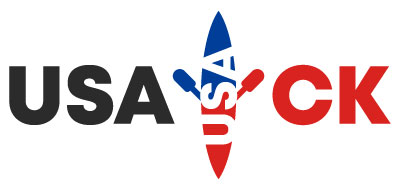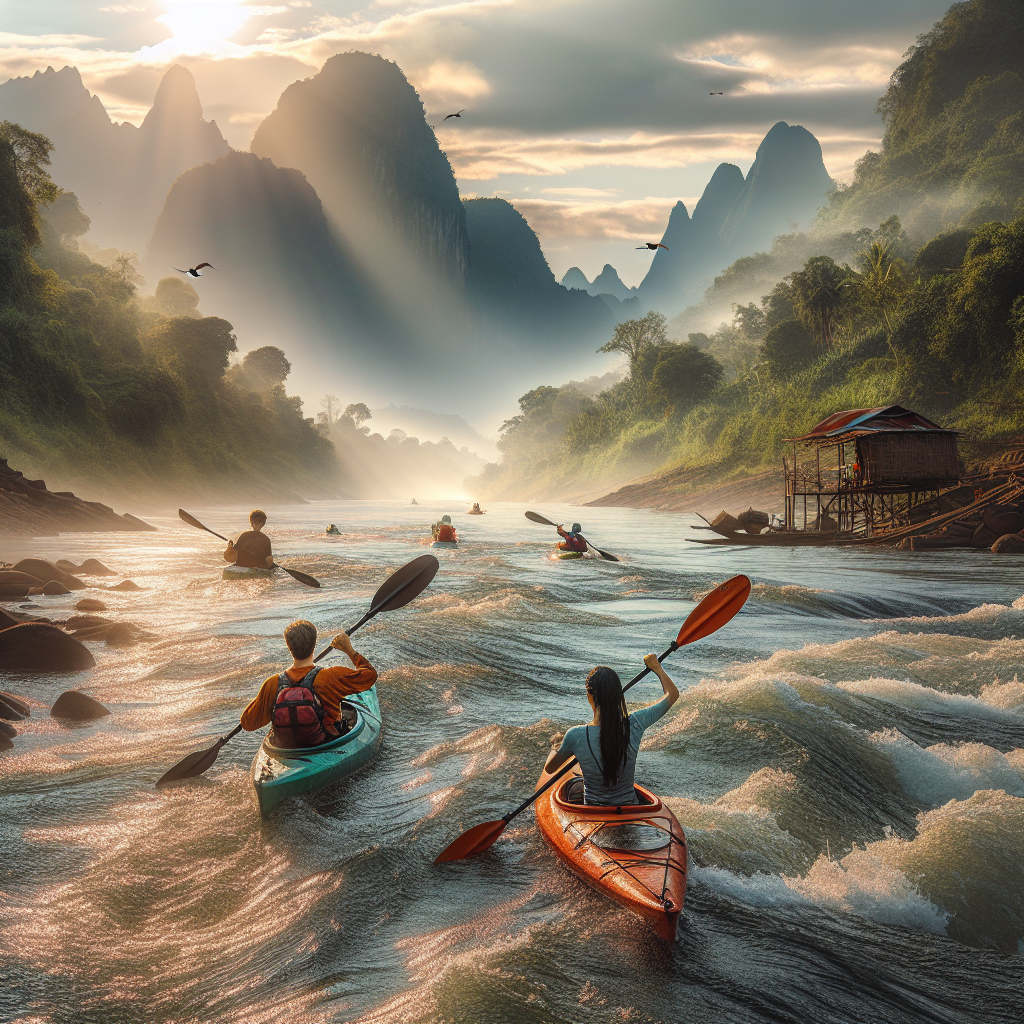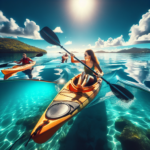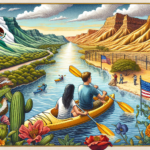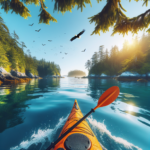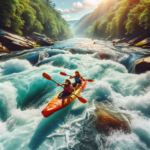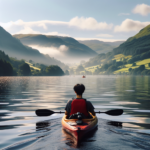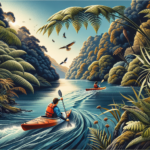Kayaking in Mekong River, Laos/Cambodia/Vietnam
Introduction to Kayaking
Kayaking is an exhilarating outdoor activity that has gained immense popularity worldwide. It offers a unique blend of adventure, exercise, and a chance to connect with nature. Whether you’re navigating through calm waters or tackling challenging rapids, kayaking provides a thrilling experience that appeals to both beginners and seasoned paddlers. The sport’s versatility and accessibility make it a favorite among outdoor enthusiasts.
In this article, we will spotlight the unique features of kayaking in the Mekong River, which flows through Laos, Cambodia, and Vietnam. This region offers a fantastic destination for kayaking enthusiasts, with its diverse landscapes, rich cultural heritage, and abundant wildlife. We’ll explore what makes the Mekong River a must-visit spot for kayakers and provide detailed information to help you plan your adventure.
Kayaking in the Mekong River is a unique experience due to its vast and varied geography, historical significance, and the vibrant cultures of the countries it traverses. The river’s diverse ecosystems and scenic beauty make it an ideal location for both leisurely paddles and more challenging expeditions. Whether you’re interested in exploring remote villages, observing wildlife, or simply enjoying the tranquility of the river, the Mekong has something to offer.
Overview of Kayaking in Mekong River, Laos/Cambodia/Vietnam
The Mekong River is one of the world’s great rivers, flowing over 4,350 kilometers from the Tibetan Plateau through China, Myanmar, Laos, Thailand, Cambodia, and Vietnam before emptying into the South China Sea. Its geography is incredibly diverse, featuring everything from mountainous regions and dense forests to expansive floodplains and delta regions. This diversity makes it an exciting destination for kayaking, offering a range of environments to explore.
The climate along the Mekong River varies significantly depending on the region and time of year. Generally, the best time to visit for kayaking is during the dry season, which runs from November to April. During this period, the weather is more predictable, and water levels are more manageable. The wet season, from May to October, can bring heavy rains and higher water levels, which may pose challenges for less experienced kayakers.
Historically, the Mekong River has been a vital lifeline for the people of Southeast Asia, serving as a major transportation route and a source of food and water. The river’s cultural significance is evident in the many traditional villages and ancient temples that line its banks. Kayaking through this region offers a unique opportunity to immerse yourself in the local culture and history, making it more than just an outdoor adventure.
Accessing the Mekong River for kayaking is relatively straightforward, with several entry points in Laos, Cambodia, and Vietnam. Major cities like Vientiane, Phnom Penh, and Ho Chi Minh City serve as convenient starting points, offering various transportation options to reach the river. Many tour operators provide guided kayaking trips, making it easy for visitors to explore the river safely and enjoyably.
Kayaking Conditions in Mekong River, Laos/Cambodia/Vietnam
The Mekong River offers a variety of water conditions that cater to different kayaking experiences. In some areas, the river is wide and calm, making it ideal for beginners and those looking for a leisurely paddle. In other sections, particularly in the upper reaches and during the wet season, the river can present more challenging conditions with stronger currents and occasional rapids.
Weather conditions along the Mekong River can vary significantly throughout the year. The dry season, from November to April, typically offers the most favorable conditions for kayaking, with lower water levels and more predictable weather. During the wet season, from May to October, heavy rains can lead to higher water levels and stronger currents, which may be more suitable for experienced kayakers seeking a challenge.
Tides and water currents are important factors to consider when planning a kayaking trip on the Mekong River. In the lower reaches of the river, particularly in the Mekong Delta region of Vietnam, tidal influences can affect water levels and currents. It’s essential to check local tide charts and plan your trip accordingly to ensure a safe and enjoyable experience.
Environmental factors such as water temperature, visibility, and potential hazards should also be taken into account. The water temperature in the Mekong River is generally warm, making it comfortable for kayaking year-round. However, visibility can vary depending on the season and location, with clearer waters typically found during the dry season. It’s also important to be aware of potential hazards such as submerged rocks, debris, and wildlife.
Top Spots for Kayaking in Mekong River, Laos/Cambodia/Vietnam
One of the top spots for kayaking on the Mekong River is the Si Phan Don region in southern Laos, also known as the “4,000 Islands.” This area is renowned for its stunning scenery, with numerous islands, waterfalls, and tranquil waterways. It’s an excellent location for both beginners and experienced kayakers, offering a mix of calm waters and gentle rapids. The best time to visit is during the dry season when water levels are lower and more manageable.
In Cambodia, the stretch of the Mekong River near Kratie is a popular destination for kayaking. This area is famous for its population of endangered Irrawaddy dolphins, which can often be spotted while paddling along the river. The scenery here is also breathtaking, with lush forests and traditional villages lining the riverbanks. The best time to visit is from December to February when the weather is cooler and more pleasant.
The Mekong Delta in Vietnam offers a unique kayaking experience with its intricate network of canals, rivers, and swamps. This region is known for its vibrant floating markets, lush rice paddies, and diverse wildlife. Kayaking through the delta allows you to explore remote areas that are inaccessible by larger boats, providing a more intimate and immersive experience. The best time to visit is during the dry season, from November to April.
Another notable spot for kayaking on the Mekong River is the area around Luang Prabang in northern Laos. This UNESCO World Heritage site is surrounded by stunning natural landscapes, including mountains, forests, and waterfalls. Kayaking here offers a mix of cultural and natural attractions, with opportunities to visit ancient temples, traditional villages, and scenic viewpoints. The best time to visit is from November to February when the weather is cooler and more comfortable.
Safety and Regulations
When kayaking on the Mekong River, it’s essential to be aware of local safety regulations and guidelines. Each country along the river has its own set of rules and regulations for water sports, so it’s important to familiarize yourself with these before embarking on your trip. In general, wearing a life jacket is mandatory, and it’s recommended to have a whistle and a waterproof map or GPS device.
Safety gear and equipment are crucial for a safe kayaking experience. In addition to a life jacket, it’s advisable to wear a helmet, especially if you’re kayaking in areas with rapids or strong currents. Other essential gear includes a paddle leash, a dry bag for personal belongings, and a first aid kit. It’s also a good idea to bring plenty of water, sunscreen, and insect repellent.
Handling emergency situations while kayaking on the Mekong River requires preparation and knowledge. It’s important to have a basic understanding of first aid and rescue techniques, as well as a plan for communication in case of an emergency. Many guided tours provide safety briefings and have experienced guides who are trained in emergency response, making them a good option for less experienced kayakers.
Respecting local regulations and guidelines is not only important for your safety but also for the preservation of the natural environment. Avoid disturbing wildlife, dispose of waste properly, and follow any specific rules or restrictions in protected areas. By doing so, you can help ensure that the Mekong River remains a beautiful and sustainable destination for future generations of kayakers.
Amenities and Accommodations
There are several amenities available for kayakers along the Mekong River, including rental facilities, guides, and tours. Many towns and cities along the river have kayak rental shops that offer a range of equipment, from basic kayaks to more advanced models. Guided tours are also widely available, providing an excellent way to explore the river with the help of experienced local guides.
Accommodation options along the Mekong River range from budget-friendly guesthouses to luxury hotels and lodges. In Laos, Cambodia, and Vietnam, you’ll find a variety of lodging options to suit different preferences and budgets. For those who prefer a more immersive experience, there are also camping sites available in some areas, allowing you to stay close to nature and enjoy the tranquility of the river.
In addition to kayaking, there are plenty of other recreational activities to enjoy along the Mekong River. These include hiking, bird watching, fishing, and visiting cultural and historical sites. Many guided tours offer multi-activity packages that combine kayaking with other outdoor adventures, providing a well-rounded experience for visitors.
When planning your trip, it’s a good idea to research the amenities and accommodations available in your chosen destination. Booking in advance is recommended, especially during peak travel seasons, to ensure you have access to the best facilities and services. Whether you’re looking for a rustic camping experience or a luxurious stay, the Mekong River has something to offer every type of traveler.
Environmental Considerations
Preserving the natural habitats and wildlife along the Mekong River is of utmost importance. As a kayaker, you can play a role in conservation efforts by practicing eco-friendly kayaking. This includes minimizing your impact on the environment, avoiding littering, and respecting wildlife by keeping a safe distance and not disturbing their natural behaviors.
Eco-friendly kayaking practices also involve using environmentally friendly products and equipment. Opt for biodegradable sunscreen and insect repellent, and avoid single-use plastics by bringing reusable water bottles and containers. When camping, follow Leave No Trace principles by packing out all waste and leaving your campsite as you found it.
There are several local conservation efforts and projects that visitors can support while kayaking on the Mekong River. These include initiatives to protect endangered species, restore natural habitats, and promote sustainable tourism practices. By supporting these efforts, you can help ensure the long-term health and vitality of the river’s ecosystems.
Educating yourself about the environmental challenges facing the Mekong River is also important. Issues such as pollution, overfishing, and habitat destruction pose significant threats to the river’s biodiversity. By staying informed and making responsible choices, you can contribute to the preservation of this vital waterway for future generations.
Highlights
When comparing kayaking on the Mekong River with other popular kayaking locations, several unique features stand out. The Mekong River’s diverse geography, rich cultural heritage, and abundant wildlife make it a one-of-a-kind destination. Unlike many other kayaking spots, the Mekong offers a blend of natural beauty and cultural experiences that are deeply intertwined with the river’s history and significance.
The biodiversity of the Mekong River is another highlight that sets it apart from other kayaking destinations. The river is home to a wide variety of species, including the endangered Irrawaddy dolphin, giant catfish, and numerous bird species. Kayaking on the Mekong provides an opportunity to observe these unique creatures in their natural habitats, making it a rewarding experience for nature enthusiasts.
Geographical features such as the 4,000 Islands in Laos, the floating villages in Cambodia, and the intricate canal systems of the Mekong Delta in Vietnam add to the river’s allure. Each of these regions offers distinct landscapes and kayaking experiences, from navigating through narrow waterways to exploring expansive floodplains. The variety of environments ensures that there’s always something new and exciting to discover.
Historically, the Mekong River has played a crucial role in shaping the cultures and societies of Southeast Asia. Kayaking along the river allows you to connect with this rich history, visiting ancient temples, traditional villages, and historical sites. This cultural immersion adds depth to your kayaking adventure, making it more than just a physical activity but also a journey through time and tradition.
FAQ Section
- What is the best season to go kayaking on the Mekong River? The best season is during the dry season, from November to April.
- Are there beginner-friendly spots for kayaking on the Mekong River? Yes, areas like Si Phan Don in Laos and the Mekong Delta in Vietnam offer calm waters suitable for beginners.
- What should I bring for a kayaking trip on the Mekong River? Essential items include a life jacket, helmet, paddle leash, dry bag, first aid kit, water, sunscreen, and insect repellent.
- Are kayak rentals available, and what are the costs? Yes, kayak rentals are available in many towns and cities along the river. Costs vary but generally range from $10 to $30 per day.
- How can I participate in local conservation efforts? You can support local conservation projects, practice eco-friendly kayaking, and follow guidelines to minimize your environmental impact.
- Are guided kayaking tours available, and what do they cover? Yes, guided tours are available and typically cover equipment rental, safety briefings, and guided exploration of scenic and cultural sites.
- What safety measures are in place for kayaking on the Mekong River? Safety measures include mandatory life jackets, recommended helmets, safety briefings, and emergency response plans provided by guided tours.
Final Thoughts
Kayaking on the Mekong River in Laos, Cambodia, and Vietnam is a premier destination for kayaking enthusiasts. The river’s diverse landscapes, rich cultural heritage, and abundant wildlife make it a unique and rewarding experience. Whether you’re a beginner or an experienced paddler, the Mekong offers something for everyone.
As you plan your kayaking adventure, remember to respect local guidelines and conservation efforts. By practicing eco-friendly kayaking and supporting local conservation projects, you can help preserve the natural beauty and biodiversity of the Mekong River for future generations.
In conclusion, kayaking on the Mekong River is more than just an outdoor activity; it’s an opportunity to connect with nature, immerse yourself in local cultures, and explore one of the world’s great rivers. We invite you to experience the beauty and thrill of kayaking on the Mekong River and create memories that will last a lifetime.
